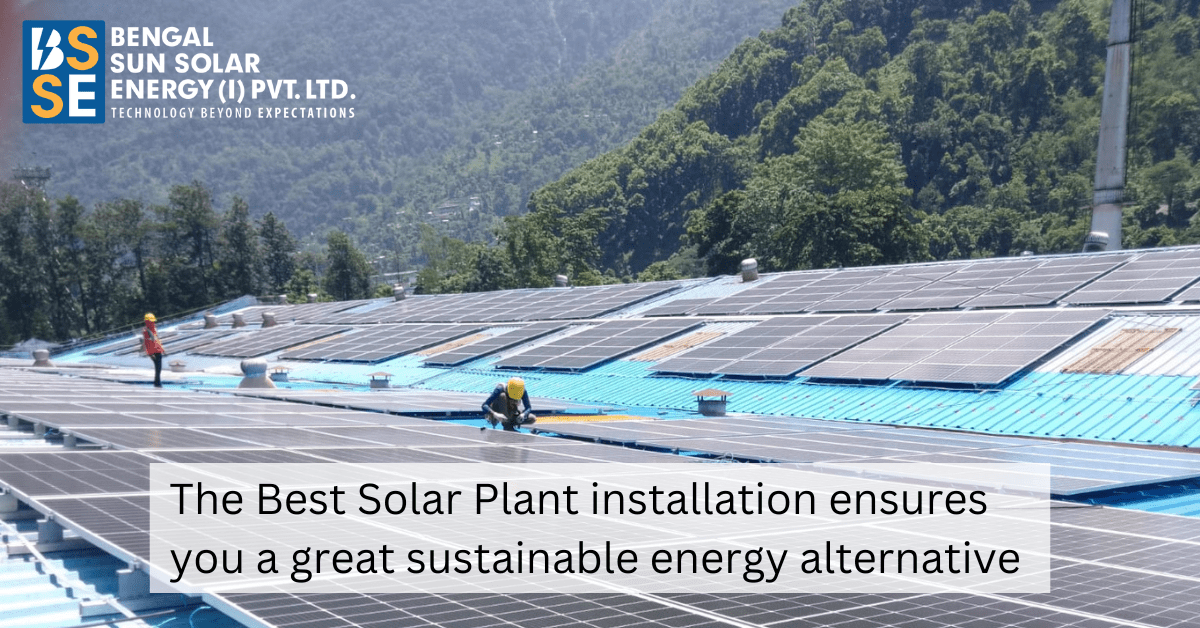The solar panels that are used in the market have a variant of maximum product durability. However, the thing that is lacking is knowledge about the solar panel. How does it work? What are its variants? How are they analyzed and what are the criteria involved? Being one of the Top Solar Plant installers in Andaman it is our duty that we enarmour our readers with the knowledge of the same. So, stay tuned and keep reading.
The Best Solar Plant installation ensures you a great sustainable energy alternative
The solar plant installation needs vast acumen and accuracy, an understanding of the materials, the anglic orientations, the material proofing and doping concepts, and so on. In the following, points we will brief you on the basics of how the solar plant work and what are various classifications done for the same. So, here it goes:
How does the Solar Plant work?
The working principle of a solar plant is a bit complicated. In this segment, we will be giving you an explanation based on the consideration that you would be understanding the intricate concept of physical chemistry. So let’s move. For the solar panel to work, there has to be something called doping, now what exactly is doping? Doping is a concept of physics. A layer of a biased (biased means where the electrons are set at a particular direction of movement) semiconductor is imparted on a chemically compatible metal. Now this semiconductor layer contains something called electronic junctions, where the photonic-to-electrical conversion takes place. The most common junction that is used in solar energy conversion is the p-n junction. The energized electrons jump from one layer of the junction to the other creating a vacancy in the lower layers which gets filled creating a voltage, now this voltage creates electricity. The excitation of the electrons happens when the sunlight touches the cells of the solar panel.
What are the Different types of solar panels and their property-based analysis?
Monocrystalline Solar Panels
Description
Monocrystalline solar panels are the most popular solar panels used today in rooftop solar panel installations. Monocrystalline silicon solar cells are manufactured using the Czochchralski method, in which a ‘seed’ silicon crystal is placed into a molten vat of pure silicon at a high temperature.
Performance
Efficiency ratings of monocrystalline solar panels range from 17% to 22%, earning them the title of the most efficient solar panel type. The higher efficiency rating of monocrystalline panels makes them ideal for homes with limited roof space, as you’ll need fewer panels to generate the electricity you need. Monocrystalline solar panels have their manufacturing process to thank for being so efficient.
Appearance
Monocrystalline panels have a solid black appearance, making them subtle on your roof. But the way monocrystalline solar cells are shaped causes there to be quite a bit of white space on the panel. Some manufacturers have worked around this with black packing or shaping the cells differently, but these aesthetic changes can impact both the price and performance of the panels.
Polycrystalline
Description
Polycrystalline panels, sometimes called ‘multi-crystalline panels’, are popular among homeowners looking to install solar panels on a budget. Similar to monocrystalline panels, polycrystalline panels are made of silicon solar cells. However, the cooling process is different, which causes multiple crystals to form instead of one. Polycrystalline panels used in residential homes usually contain 60 solar cells.
Performance
Polycrystalline panel efficiency ratings will typically range from 15% to 17%. The lower efficiency ratings are due to how electrons move through the solar cell. Because polycrystalline cells contain multiple silicon cells, the electrons cannot move as easily and as a result, decrease the efficiency of the panel. The lower efficiency of polycrystalline panels also means they tend to have a lower power output than monocrystalline panels, usually ranging between 240 watts and 300 watts.
Appearance
Historically, polycrystalline panels have been the cheapest option for homeowners going solar, without majorly sacrificing panel performance, Low prices allowed polycrystalline panels to make up a significant market share in residential solar installations between 2012 and 2016. But as we said earlier, the price gap between monocrystalline and polycrystalline panels is narrowing. Now, more homeowners are willing to pay a slightly higher price to get significantly better efficiency and power ratings from monocrystalline panels.
Thin Film
Description
Thin film solar cells are mostly used in large-scale utility and industrial solar installations because of their lower efficiency ratings. Thin film solar panels are made by depositing a thin layer of a photovoltaic substance onto a solid surface, like glass. Some of these photovoltaic substances include Amorphous silicon (a-Si), copper indium gallium selenide (CIGS), and cadmium telluride (CdTe).
Performance
Thin film solar panels have incredibly low-efficiency ratings. As recently as a few years ago, thin film efficiencies were in the single digits. Researchers have recently achieved 23.4% efficiency with thin-film cell prototypes but thin-film panels that are commercially available generally have efficiency in the 10-13% range.
Appearance
Thin film panels have a clean, all-black look. Their thin design allows them to lie flat against roofs, so they can blend in more seamlessly. In fact, with some thin film panels, it’s hard to even see the individual cells within the panel.
This is just a brief summarization of the different types of solar panels, and their brief characteristics. However, for the Best Solar Plant Installation, you can always trust BSSE.
